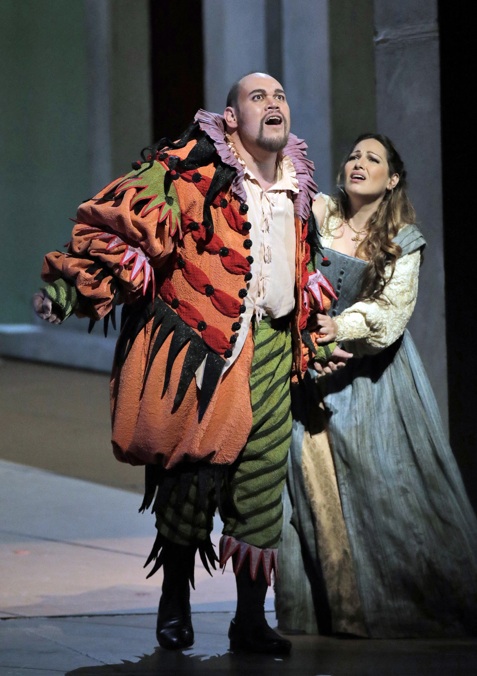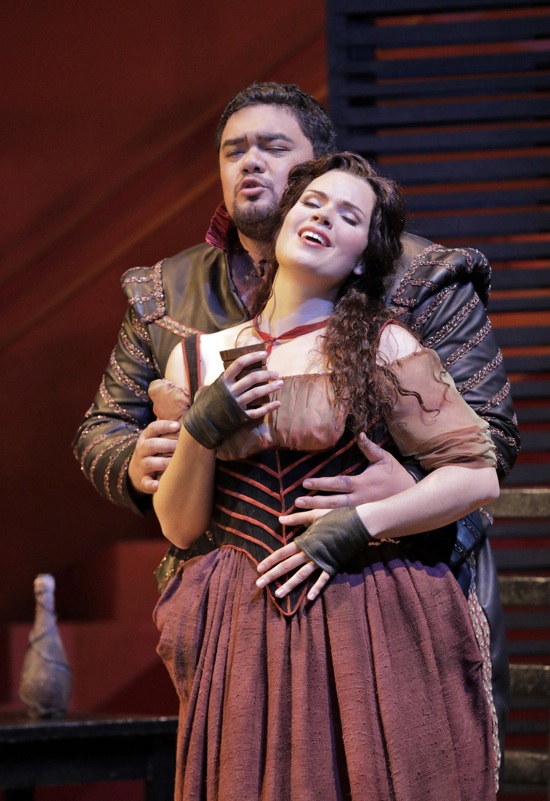Cursed jesters and slippery Dukes
Giuseppe Verdi’s Rigoletto was unexpectedly crowd pleasing last Tuesday, June 6, at San Francisco’s War Memorial Opera House. Nicola Luisotti led the SF Opera in a careful production that emphasized the beauty of the craft rather than dwelling too deeply on the menacing action.
But that was only a little surprising. Patrons strolled out wreathed with smiles after an evening of rape and murder, rather than slinking out in shock, a response to great music performed perfectly and famous arias sung to a tee.
Two artists propelled that bonhomie. Hawaiian baritone Quinn Kelsey was outstanding as the hunchback jester, Rigoletto. This has become his signature role, and that was apparent from his first tragic entrance. Kelsey’s voice was warm and hoarse, enveloping the “edges” of the notes and dominating the stage. Coupled with an emotional intensity that felt fresh, this was a treat.
 The jester’s patron was the skirt chasing Duke of Mantua, sung by Samoan tenor Pene Pati with some of the brightness and honey of a young Pavarotti. There was a quality of inner joy to his delivery, particularly in the well-known “La Dona e mobile,” where he was obviously having so much fun that it was easy to forgive the misdeeds of royalty.
The jester’s patron was the skirt chasing Duke of Mantua, sung by Samoan tenor Pene Pati with some of the brightness and honey of a young Pavarotti. There was a quality of inner joy to his delivery, particularly in the well-known “La Dona e mobile,” where he was obviously having so much fun that it was easy to forgive the misdeeds of royalty.
The object of their attentions was the jester’s daughter, Gilda, sung by Nino Machaidze. That soprano could easily wake the back rows, but the heavy power that carried it back there wasn’t ideal for duets – and this was one opera where duets carried a lot of the action. But in her quieter moments that big glittery vibrato turned into a smooth river of gold, and her “Caro nome” was a triumph, along with her first duet with Rigoletto,
Those three were surrounded by artists who knew how to have fun. Two basses anchored the action, Andrea Silvestrelli as the assassin Sparafucile and Reginald Smith, Jr. as Count Monterone, and both grabbed their scenes. Silvestrelli’s low growls were as arresting as the coughs of a lion as it builds to a roar, while Smith’s over-sized timbre was bronzed and meaty.
Two women completed the vocal support. Soprano Buffy Baggott sang the part of Giovanna, the house servant, with a chocolaty voice that was surprisingly agile, and mezzo Zanda Svede, as the assassin’s sister, was absolutely gorgeous in the lower register, even though her voice has not yet filled out.
Those satisfying voices were delivered over Verdi’s glorious music. The soft cadence of horns opened the opera, royal and threatening, punctuated by rumbles of timpani, a heart-stopping sound that could have emanated through cracks in the gates of hell. Then violins switched it up for a lively dance, and Verdi was gaily painting his festive screen over the court’s evil.
Along with lovely orchestration, there were signature themes for the characters. After being cursed by Monterone for encouraging the abduction of his daughter, Kelsey sang “Pari siamo,” musing, “We are alike. I have my tongue, he has his dagger.” His melody is led by flute, and Verdi does that again for Gilda’s lovely aria, “Caro nome.” Here, the flute rose in suggestive arpeggios, then slowly stepped down a major scale that was simple and innocent, and the voice followed and embroidered. In a later aria the oboe cast a warm and mournful net before her, and in her dying aria the flute turned back to major and again steered her notes to innocence. A masterful character development!
 The stark fourteenth century sets were inspired by de Chirico, a Surrealist painter, with towers exaggerated in their rake and perspective and leaning in like rotten teeth. The lighting was also extreme, harsh with reds and blues. In the very first scene dark figures stood backlit with red, and Rigoletto slowly advanced to the front until his face resolved into visibility. That lighting was almost a caricature, and that curiously allowed us to more easily enter the story. Later, Rigoletto and Gilda sang a loving father-daughter duet, backlit in menacing reds, while the shadows in the street outside were just as sharply painted in cold blues. That lighting was a premonition of the hell they create out of love.
The stark fourteenth century sets were inspired by de Chirico, a Surrealist painter, with towers exaggerated in their rake and perspective and leaning in like rotten teeth. The lighting was also extreme, harsh with reds and blues. In the very first scene dark figures stood backlit with red, and Rigoletto slowly advanced to the front until his face resolved into visibility. That lighting was almost a caricature, and that curiously allowed us to more easily enter the story. Later, Rigoletto and Gilda sang a loving father-daughter duet, backlit in menacing reds, while the shadows in the street outside were just as sharply painted in cold blues. That lighting was a premonition of the hell they create out of love.
Any tragedy that leaves one whistling has got to have something both right and wrong with it. Perhaps its Verdi’s memorable tunes, with three great arias in just this one opera.
And maybe it’s the times. In this strange world of alternative facts, it seems natural for the Duke to slip away from accountability, to flit from one maiden to the next, whisper earnest lies and even be defended by the victim of his rape.
Verdi’s audience had a long history with such Dukes. Our new normal is not so new, is it?
There are three more performances: Thursday 6/22, Tuesday 6/27 and Saturday 7/1, all at 7:30 p.m. See sfopera.com for tickets.
—Adam Broner
Photo top of Quinn Kelsey as Rigoletto and Nino Machaidze as Gilda in Verdi’s Rigoletto at the San Francisco Opera; below, Pene Pati as the Duke of Mantua and Zanda Svede as Maddalena; both photos by Cory Weaver.
